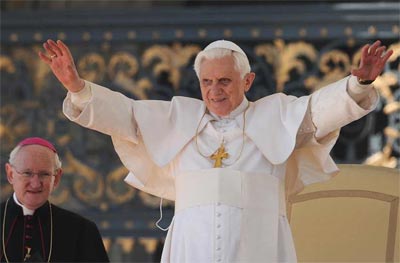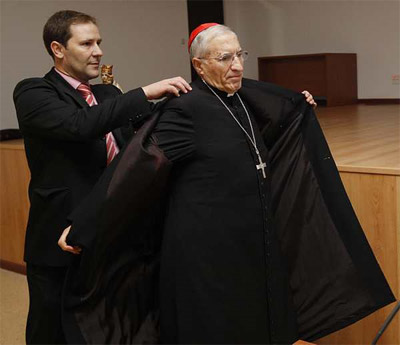 Stop NATO
Stop NATO March 20, 2010
NATO: AFRICOM’s Partner In Military Penetration Of Africa
Rick Rozoff
The world’s oldest extant military bloc (formed 61 years ago) and the largest in history (twenty eight full members and as many partners on five continents), the North Atlantic Treaty Organization, counts among its major member states all of Africa’s former colonial powers: Britain, France, Portugal, Spain, Italy, Germany and Belgium.
After World War II and the groundswell of anti-colonial sentiment throughout Africa and Asia, the European powers were forced to withdraw from most of the African continent, though Portugal retained its possessions until the 1970s.
Most new African nations adopted some model of socialist-oriented economic and political development and the continent as a whole more closely aligned itself with the Soviet Union, which moreover had for decades supported the anti-colonial struggles in Africa, than with the West, both Western Europe and the United States.
With the end of the Cold War and the breakup of the Soviet Union nearly twenty years ago, the major Western powers on both sides of the Atlantic Ocean, united under the aegis of NATO, saw that as with the Balkans and the former republics of the Soviet Union itself, Africa was now wide open for penetration and domination.
NATO’s largest, most powerful and dominant member is of course the United States. On October 1, 2007 the Pentagon established United States Africa Command (AFRICOM) under the temporary wing of United States European Command, which at the time included in its area of responsibility all of Africa except for four island nations in the Indian Ocean and the Horn of Africa states and Egypt. (The first were in Pacific Command and the others in Central Command where Egypt, alone among Africa’s 53 nations, remains.)
A year to the day later AFRICOM was launched as the first new U.S. regional military command outside North America since Central Command was activated 25 years earlier in 1983. It takes in far more nations – 52 – than any other military command in history.
AFRICOM was conceived, carried, nurtured and delivered by the Pentagon’s European Command (EUCOM), based in Stuttgart, Germany where AFRICOM headquarters are also based as no nation in Africa has yet volunteered to be the host.
The top commander of EUCOM is “dual-hatted” as NATO’s Supreme Allied Commander Europe (SACEUR) and has been from General Dwight D. Eisenhower in 1951 to Admiral James Stavridis today.
The three top EUCOM/NATO military commanders most instrumental in the creation of AFRICOM were General Joseph Ralston (2000-2003), General James Jones (2003-2006) and General Bantz John Craddock (2006-2009). Arguably Jones, former Marine Corps four-star general and current U.S. National Security Adviser, was the real father of Africa Command. [1]
The distinction between the Pentagon and NATO in relation to Europe and Africa – and increasingly the Caucasus, the Caspian Sea Basin, Central Asia, South Asia and the Indian Ocean – is blurred and more and more of a strictly formal nature.
NATO has now joined AFRICOM’s first war, in Somalia.
The bloc’s Allied Command Operations website announced on March 18 that from March 5-16 the North Atlantic military alliance had airlifted 1,700 Ugandan troops from their homeland to the Somali capital of Mogadishu for the intensified fighting that began there earlier this month.
The Pentagon supplied the transport planes “under the NATO banner” and the operation was “undertaken by USA contracted DynCorp International.” [2]
The commander of AFRICOM, General William Ward, recently informed the Senate Armed Services Committee of plans to focus the military command’s attention on East Africa and indicated plans to assist the formal government of Somalia to reclaim the country’s capital.
In May the European Union is to began training 2,000 Ugandan troops for deployment to war-wracked Somalia to assist the regime being propped up by the West.
NATO recently confirmed that it has prolonged an agreement to provide strategic sealift and airlift support for African (Ugandan, Rwandan and Burundian) troops to assist Somalia’s Transitional Federal Government in the nation’s civil war.
The bloc’s European command, Supreme Headquarters Allied Powers Europe (SHAPE), “delegated the authority to Joint Command Lisbon to have the operational lead for NATO engagements with the African Union and they provide the majority of the personnel to support the mission.” [3]
As with the government of Hamid Karzai in Afghanistan, the Western-backed Transitional Federal Government doesn’t even control its own capital. Since last week fighting there has led to hundreds of people being killed and wounded and thousands displaced.
Six days earlier NATO effected a changing of the guard “in the Gulf of Aden and Somali Basin” [4] as part of its Operation Ocean Shield, and five warships of the Standing NATO Maritime Group 2 joined four from the Standing NATO Maritime Group 1 in Djibouti, where there are some 2,000 U.S. troops and where AFRICOM bases its Combined Joint Task Force-Horn of Africa. Djibouti also hosts over 1,000 French soldiers and France’s second largest military base abroad.
On March 10 NATO extended its deployment of warships in the Gulf of Aden and the Horn of Africa until the end of 2012 in what originally was portrayed as an ad hoc, short-term deployment when Operation Ocean Shield was initiated last August following Operation Allied Protector in March. Instead, NATO has effectively expanded its over eight-year-old naval operation in the Mediterranean Sea, Operation Active Endeavor, through the Red Sea and into the Arabian Sea and is now involved in the Horn of Africa both on land and at sea.
The Standing NATO Maritime Groups consist of warships from member states assigned for the occasion – the latest deployment in the Gulf of Aden includes a U.S. ship – and is under the command of Allied Component Command Maritime Naples, one of the two Component Commands of Allied Joint Force Command Naples.
Allied Joint Force Command Naples (JFC Naples) was inaugurated six years ago as part of NATO strategy to deploy further south and east, succeeding Allied Forces Southern Europe (AFSOUTH). The reorganization was a component of Alliance transformation policy growing out of the 2002 NATO summit in Prague. JFC Naples takes in the entire NATO Area of Responsibility (AOR) which, as will be seen, includes the Balkans, Africa, the Mediterranean Sea region and Iraq.
Its commander is the U.S.’s Admiral Mark Fitzgerald, who is also the top commander of U.S. Naval Forces Europe and U.S. Naval Forces Africa. Earlier this year Fitzgerald was in Kosovo threatening Serbian authorities in the north, branding them “a threat to Kosovo stability.” [5]
NATO’s Naples Command has offices and is involved in operations throughout the Balkans: In Albania, Bosnia, Kosovo, Macedonia and Serbia.
The NATO Training Mission – Iraq is also conducted under JFC Naples’s supervision. (Its first commander was General David Petraeus, now in charge of United States Central Command.)
In his dual capacity as head of U.S. naval forces in Europe and Africa, Fitzgerald is also in charge of the Pentagon’s Africa Partnership Station (APS), created in 2006 and now part of AFRICOM.
Its first deployment was to West Africa, including the Gulf of Guinea, in 2007 and 2008 when the USS Fort McHenry and HSV (High Speed Vessel) Swift visited Equatorial Guinea, Gabon, Ghana, Senegal, Sao Tome and Principe, and Togo. Former NATO Supreme Allied Commander, current U.S. National Security Adviser, James Jones years ago marked off that expanse of Africa along its Atlantic Coast as a vital theater in the battle for world oil supplies. [6]
On March 13 the U.S. began military exercises in Ghana which will last to the end of the month.
“The three-week exercise, with about 120 Ghana Armed Forces personnel and about 95 US Marines, forms part of the Africa Partnership Station (APS) 2010 project.” [7]
The operation is the first of three U.S. Marines will conduct in Africa this year.
The day before the Ghanaian maneuvers began, AFRICOM completed the Africa Partnership Station East operation at the other end of the continent.
On its final day a review was held in Mombasa, Kenya with leaders from Kenya, Namibia, Tanzania and the U.S., which was hosted by Admiral Mark Fitzgerald of U.S. Naval Forces Europe-Africa (and NATO’s Allied Joint Force Command Naples).
Two American warships were deployed for the occasion, the frigate USS Nicholas and HSV Swift.
A Kenyan naval officer described what preceded the exercises in East Africa: “From Naples, the ships steamed to Souda Bay, Greece, and then through the Suez Canal to our first Africa Partnership Station engagement in Djibouti.
“During this deployment, Swift and Nicholas covered a total of 12,500 nautical miles and conducted 11 ports of calls; namely, Mombasa, Kenya; Dar es salaam, Tanzania; Durban and Cape Town, South Africa; Maputo, Mozambique; Port East, Reunion; Port Louis, Mauritius; and Port Victoria, Seychelles.” [8]
The commander of Africa Partnership Station East, Captain James Tranoris, described its significance: “While APS has been active in East Africa for a few years, this year marks the inaugural deployment of an international staff to execute the mission.”
AFRICOM’s APS has established itself in both the Gulf of Guinea and the western shores of the Indian Ocean.
At the north end of the continent, Admiral Giampaolo Di Paola, chairman of the NATO Military Committee, was in Algeria to promote both the Mediterranean Dialogue partnership and the Alliance’s new Strategic Concept.
The first is a NATO program that includes Algeria, Egypt, Israel, Jordan, Mauritania, Morocco and Tunisia, expanding the bloc’s influence – and presence – from both banks of the Jordan River to well down Africa’s western coast.
The second is the formalization of NATO’s 21st century military strategy to further the global, expeditionary character of the military bloc.
“During his address the Chairman underlined the cooperation between NATO and Algeria in the framework of the Mediterranean Dialogue and praised Algeria’s great contribution to the formation of its Officers in the NATO Regional Cooperation Course (NRCC) at the NATO Defense College (NDC).
“Admiral Di Paola also stressed the need to bring forward Mediterranean Dialogue views into the New NATO Strategic Concept.” [9]
Di Paola also visited Morocco and delivered a speech on “the new NATO Strategic Concept to officers of the Royal Moroccan Army General Staff.
“He praised the cooperation between NATO and Morocco in the framework of the Mediterranean Dialogue and the contribution of the Royal Moroccan Armed Forces to NATO operations,” and urged the “ongoing development of the new Strategic Concept to strengthen the ties between NATO and its Mediterranean partners.” [10]
In 1884 the major European powers gathered at the Berlin Conference to divide up those parts of Africa that had escaped colonization and to create a consortium to dominate and exploit an entire continent and its peoples.
The anti-colonial struggles after the Second World War put an end to that enforced order, but 126 years later there are ominous indications that the former colonial masters are nostalgic for their past power.
1) Global Energy War: Washington’s New Kissinger’s African Plans
Stop NATO, January 22, 2009
http://rickrozoff.wordpress.com/2009/08/26/global-energy-war-washingtons-new-kissingers-african-plans2) North Atlantic Treaty Organization
Allied Command Operations
March 18, 2010
3) Ibid
4) North Atlantic Treaty Organization, March 12, 2010
5) 11 Years Later: NATO Powers Prepare Final Solution In Kosovo
Stop NATO, March 18, 2010
http://rickrozoff.wordpress.com/2010/03/19/11-years-later-nato-powers-prepare-final-solution-in-kosovo6) Global Energy War: Washington’s New Kissinger’s African Plans
7) Ghana Government, March 18, 2010
8) United States Africa Command
Africa Partnership Station
March 17, 2010
9) North Atlantic Treaty Organization
International Military Staff
March 15, 2010
10) North Atlantic Treaty Organization
International Military Staff
March 18, 2010
http://rickrozoff.wordpress.com/


